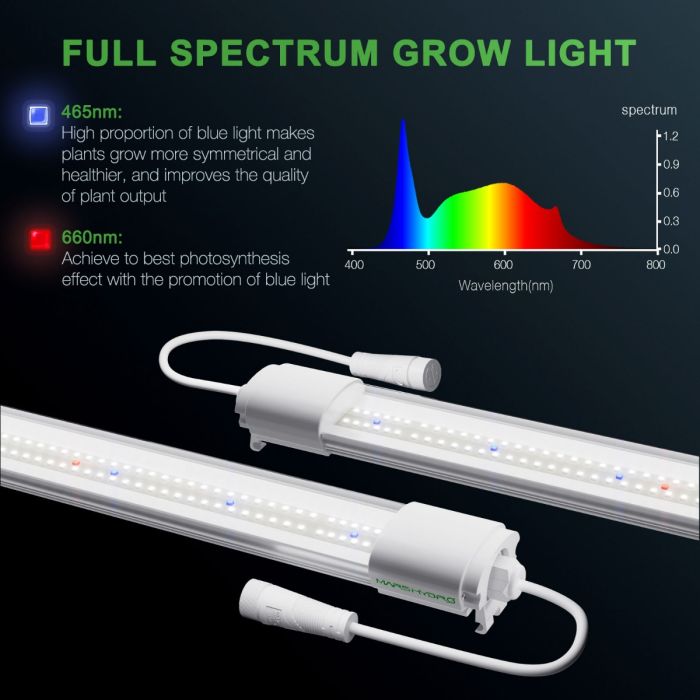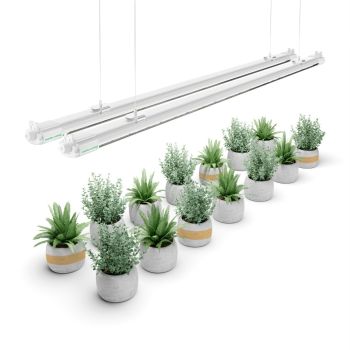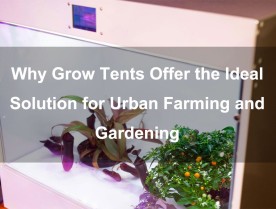
Gardening, whether indoors or outdoors, provides a deep connection with nature and a sense of fulfillment as we observe the growth of our cherished plants. However, to truly maximize their potential, plants need more than just soil, water, and sunlight. This is where supplemental lighting, particularly under-canopy lighting, becomes essential – playing a crucial role in fostering robust plant health and growth.
As controlled environments refine their cultivation techniques, the role of under-canopy lighting is poised to undergo significant evolution. Its potential applications in greenhouses, both as supplemental lighting in the absence of top lighting and in situations where root temperatures are low, introduce new opportunities for growers. Moreover, these benefits extend beyond weed cultivation, offering exciting prospects for high-value crops with dense sub-canopies.
Understanding Under Canopy Lighting
Under canopy lighting serves as a strategic approach to illuminate the often neglected lower sections of plant canopies. While traditional gardening practices have primarily focused on overhead illumination, recent advancements in technology and our deepening understanding of plant biology have underscored the critical importance of adequately lighting the lower regions. This realization has prompted the adoption of innovative under canopy lighting solutions like the Mars Hydro VG Series. These advancements aim to provide holistic lighting coverage, ensuring that every part of the plant receives the light it needs for optimal growth and development.
The Role of Under Canopy Lighting
The role of under canopy lighting in horticulture is multifaceted and crucial for achieving optimal plant health and productivity. One of its primary functions is to address the issue of uneven light distribution within the plant canopy. In natural environments, sunlight penetrates through the foliage, reaching even the lower leaves and stems. However, in indoor settings or densely planted outdoor gardens, the lower parts of plants often receive insufficient light due to shading from upper foliage.
Under canopy lighting strategically supplements natural light by illuminating the lower portions of plants. By doing so, it mitigates the shading effects caused by dense foliage, ensuring that all parts of the plant receive adequate light for photosynthesis. This balanced light distribution plays a vital role in promoting uniform growth throughout the plant canopy, preventing issues such as leggy growth or weak lower branches.
Moreover, under canopy lighting directly impacts photosynthetic activity in the lower plant areas. Photosynthesis, the process by which plants convert light energy into chemical energy, primarily occurs in chloroplasts located in the leaves. However, leaves in the lower canopy receive less direct sunlight, resulting in lower rates of photosynthesis compared to upper leaves. Supplemental lighting from below helps to optimize photosynthetic rates in these lower regions, promoting robust growth and overall plant health.
Furthermore, bottom lighting enhances nutrient uptake and metabolism in plants. Adequate light is essential for driving the process of nutrient absorption through the roots and their subsequent transport to various parts of the plant. By ensuring that even the lower leaves and stems receive sufficient light, under canopy lighting facilitates efficient nutrient uptake, which is essential for supporting vital physiological processes and promoting overall plant vigor.
Ultimately, the benefits of bottom lighting extend beyond mere growth enhancement to yield superior quality produce. By providing uniform light distribution throughout the plant canopy, under canopy lighting contributes to the development of well-formed, healthy leaves, flowers, and fruits. This not only enhances the aesthetic appeal of the plants but also improves the nutritional quality and flavor of the harvest.
Why is Under Canopy Lighting Crucial for Plant Growth?

When growing plants on benches or racks, the limited sunlight that reaches beneath the top canopy often impedes the development of lower buds and leaves. Recognizing this challenge, it becomes crucial to install under canopy grow lights, also known as interlighting, to optimize plant development. In plant cultivation, under canopy lighting plays a pivotal role. It promotes the growth of buds on lower branches, reducing the necessity for labor-intensive pruning. Additionally, this form of lighting can significantly enhance the overall quality of plants by improving the structure, density, and color of C and B buds. Moreover, it can potentially boost yield outputs by up to 60%, making it an invaluable addition to any indoor farming setup. This approach not only maximizes light exposure to all parts of the plant but also ensures more efficient and productive growth cycles.
Understanding the importance of under canopy lighting for plant growth involves examining the intricate details of plant physiology beyond the basic overhead lighting approach. In nature, sunlight filters down through the layers of foliage, ensuring even the lowest leaves receive necessary light. This natural distribution of light is essential for robust plant growth, and replicating this indoors is crucial for optimal growing conditions.
Failure to provide sufficient light to the lower parts of the plant can lead to several growth challenges. The lower leaves, crucial for photosynthesis and nutrient absorption, might receive inadequate light, resulting in stunted growth, fewer flowering sites, and overall reduced plant productivity. This is because these lower leaves are essential in supporting the plant’s metabolic functions, but without enough light, their performance declines.
Integrating under canopy lighting in indoor setups helps to ensure that light reaches all parts of the plant, mimicking the natural light exposure seen in outdoor environments. This method of lighting promotes balanced growth throughout the entire plant, supporting the development of healthy flowers and fruits, which can lead to increased yields and better quality produce.
Under canopy lighting is more than just a supplemental light source; it's a critical element for creating conditions akin to those found in nature, which are necessary for optimal plant growth. This approach is particularly beneficial in dense planting arrangements where overhead light fails to penetrate to the lower canopy, potentially resulting in underdeveloped lower buds, often referred to as "popcorn" buds due to their small and fluffy appearance. By ensuring these lower buds receive adequate light, under canopy lighting not only promotes fuller growth but also enhances overall cultivation efficiency, as well-lit plants can photosynthesize more effectively, making the most of their environment.
Suitable Lighting Options for Under Canopy Lighting
When it comes to selecting lighting solutions for bottom illumination, LED (Light Emitting Diode) lights stand out as the preferred choice in plant cultivation for several reasons.
LED lights are highly energy-efficient, converting a greater percentage of electrical energy into usable light compared to traditional options. This efficiency reduces energy waste and lowers electricity costs for indoor gardening setups. Additionally, LED lights offer customizable spectra, allowing growers to fine-tune the light output to match the specific requirements of different plant species and growth stages, optimizing photosynthesis, flowering, and fruiting for healthier plants and increased yields. LED lights also emit significantly less heat than traditional sources like HPS (High-Pressure Sodium) or MH (Metal Halide) lights, reducing the risk of heat damage and maintaining a stable growing environment. Moreover, LED lights have a longer lifespan, lasting tens of thousands of hours before needing replacement, which reduces maintenance costs and ensures consistent performance. The compact design of LED lights makes them versatile for various growing spaces and layouts, and their environmentally friendly nature, free from hazardous materials like mercury, makes them a sustainable choice for indoor cultivation.
Mars Hydro VG Series embodies these qualities, offering a tailored spectrum for different growth stages, adjustable intensity, and uniform light spread to promote optimal photosynthesis and metabolic activities throughout the plant canopy. Additionally, their energy-efficient design minimizes heat generation and operational costs, making them an environmentally sustainable choice for indoor cultivation.
Conclusion
In conclusion, the integration of under canopy lighting, epitomized by Mars Hydro VG Series, heralds a paradigm shift in indoor gardening practices. By addressing the inherent limitations of traditional overhead lighting, it paves the way for enhanced productivity, quality, and sustainability. As we continue to unravel the complexities of plant-environment interactions, embracing innovative solutions like under canopy lighting becomes imperative for unlocking the full potential of indoor cultivation.









